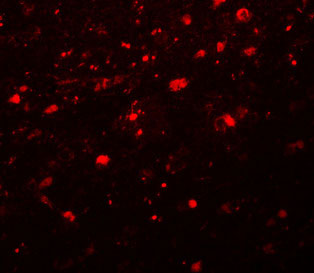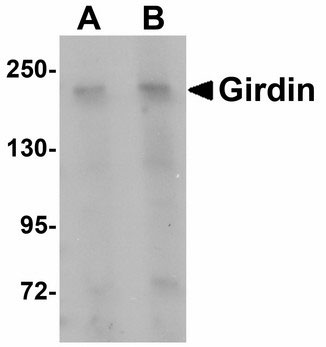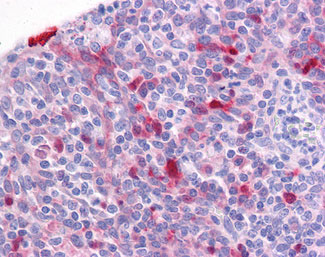CCDC88A / GIV / Girdin Antibody (C-Terminus)
Rabbit Polyclonal Antibody
- SPECIFICATION
- CITATIONS
- PROTOCOLS
- BACKGROUND

Application
| WB, IHC-P, IF, E |
|---|---|
| Primary Accession | Q3V6T2 |
| Reactivity | Human, Mouse, Rat |
| Host | Rabbit |
| Clonality | Polyclonal |
| Calculated MW | 216kDa |
| Dilution | IHC-P (5 µg/ml), WB (1-2 µg/ml), |
| Gene ID | 55704 |
|---|---|
| Other Names | Girdin, Akt phosphorylation enhancer, APE, Coiled-coil domain-containing protein 88A, G alpha-interacting vesicle-associated protein, GIV, Girders of actin filament, Hook-related protein 1, HkRP1, CCDC88A |
| Target/Specificity | Human KIAA1212 |
| Reconstitution & Storage | Short term 4°C, long term aliquot and store at -20°C, avoid freeze thaw cycles. Store undiluted. |
| Precautions | CCDC88A / GIV / Girdin Antibody (C-Terminus) is for research use only and not for use in diagnostic or therapeutic procedures. |
| Name | CCDC88A |
|---|---|
| Function | Bifunctional modulator of guanine nucleotide-binding proteins (G proteins) (PubMed:19211784, PubMed:27621449). Acts as a non-receptor guanine nucleotide exchange factor which binds to and activates guanine nucleotide-binding protein G(i) alpha subunits (PubMed:19211784, PubMed:21954290, PubMed:23509302, PubMed:25187647). Also acts as a guanine nucleotide dissociation inhibitor for guanine nucleotide- binding protein G(s) subunit alpha GNAS (PubMed:27621449). Essential for cell migration (PubMed:16139227, PubMed:19211784, PubMed:20462955, PubMed:21954290). Interacts in complex with G(i) alpha subunits with the EGFR receptor, retaining EGFR at the cell membrane following ligand stimulation and promoting EGFR signaling which triggers cell migration (PubMed:20462955). Binding to Gi-alpha subunits displaces the beta and gamma subunits from the heterotrimeric G-protein complex which enhances phosphoinositide 3-kinase (PI3K)-dependent phosphorylation and kinase activity of AKT1/PKB (PubMed:19211784). Phosphorylation of AKT1/PKB induces the phosphorylation of downstream effectors GSK3 and FOXO1/FKHR, and regulates DNA replication and cell proliferation (By similarity). Binds in its tyrosine-phosphorylated form to the phosphatidylinositol 3-kinase (PI3K) regulatory subunit PIK3R1 which enables recruitment of PIK3R1 to the EGFR receptor, enhancing PI3K activity and cell migration (PubMed:21954290). Plays a role as a key modulator of the AKT-mTOR signaling pathway, controlling the tempo of the process of newborn neuron integration during adult neurogenesis, including correct neuron positioning, dendritic development and synapse formation (By similarity). Inhibition of G(s) subunit alpha GNAS leads to reduced cellular levels of cAMP and suppression of cell proliferation (PubMed:27621449). Essential for the integrity of the actin cytoskeleton (PubMed:16139227, PubMed:19211784). Required for formation of actin stress fibers and lamellipodia (PubMed:15882442). May be involved in membrane sorting in the early endosome (PubMed:15882442). Plays a role in ciliogenesis and cilium morphology and positioning and this may partly be through regulation of the localization of scaffolding protein CROCC/Rootletin (PubMed:27623382). |
| Cellular Location | Cell membrane; Peripheral membrane protein. Cytoplasm, cytosol. Cytoplasmic vesicle. Cell projection, lamellipodium. Cytoplasm, cytoskeleton, cilium basal body. Cytoplasm, cytoskeleton, microtubule organizing center, centrosome, centriole. Note=Localizes to the cytosol in unstimulated cells while EGF stimulation promotes membrane localization and guanine nucleotide exchange factor activity (PubMed:27864364) Localizes to the cell membrane through interaction with phosphoinositides (PubMed:15882442, PubMed:16139227) |
| Tissue Location | Expressed ubiquitously. |

Thousands of laboratories across the world have published research that depended on the performance of antibodies from Abcepta to advance their research. Check out links to articles that cite our products in major peer-reviewed journals, organized by research category.
info@abcepta.com, and receive a free "I Love Antibodies" mug.
Provided below are standard protocols that you may find useful for product applications.
Background
Plays a role as a key modulator of the AKT-mTOR signaling pathway controlling the tempo of the process of newborn neurons integration during adult neurogenesis, including correct neuron positioning, dendritic development and synapse formation. Enhances phosphoinositide 3-kinase (PI3K)-dependent phosphorylation and kinase activity of AKT1/PKB, but does not possess kinase activity itself. Phosphorylation of AKT1/PKB thereby induces the phosphorylation of downstream effectors GSK3 and FOXO1/FKHR, and regulates DNA replication and cell proliferation (By similarity). Essential for the integrity of the actin cytoskeleton and for cell migration. Required for formation of actin stress fibers and lamellipodia. May be involved in membrane sorting in the early endosome.
References
Enomoto A.,et al.Dev. Cell 9:389-402(2005).
Simpson F.,et al.Traffic 6:442-458(2005).
Anai M.,et al.Submitted (NOV-2003) to the EMBL/GenBank/DDBJ databases.
Hillier L.W.,et al.Nature 434:724-731(2005).
Bechtel S.,et al.BMC Genomics 8:399-399(2007).
If you have used an Abcepta product and would like to share how it has performed, please click on the "Submit Review" button and provide the requested information. Our staff will examine and post your review and contact you if needed.
If you have any additional inquiries please email technical services at tech@abcepta.com.













 Foundational characteristics of cancer include proliferation, angiogenesis, migration, evasion of apoptosis, and cellular immortality. Find key markers for these cellular processes and antibodies to detect them.
Foundational characteristics of cancer include proliferation, angiogenesis, migration, evasion of apoptosis, and cellular immortality. Find key markers for these cellular processes and antibodies to detect them. The SUMOplot™ Analysis Program predicts and scores sumoylation sites in your protein. SUMOylation is a post-translational modification involved in various cellular processes, such as nuclear-cytosolic transport, transcriptional regulation, apoptosis, protein stability, response to stress, and progression through the cell cycle.
The SUMOplot™ Analysis Program predicts and scores sumoylation sites in your protein. SUMOylation is a post-translational modification involved in various cellular processes, such as nuclear-cytosolic transport, transcriptional regulation, apoptosis, protein stability, response to stress, and progression through the cell cycle. The Autophagy Receptor Motif Plotter predicts and scores autophagy receptor binding sites in your protein. Identifying proteins connected to this pathway is critical to understanding the role of autophagy in physiological as well as pathological processes such as development, differentiation, neurodegenerative diseases, stress, infection, and cancer.
The Autophagy Receptor Motif Plotter predicts and scores autophagy receptor binding sites in your protein. Identifying proteins connected to this pathway is critical to understanding the role of autophagy in physiological as well as pathological processes such as development, differentiation, neurodegenerative diseases, stress, infection, and cancer.




